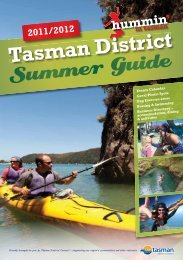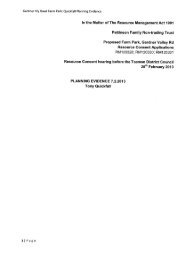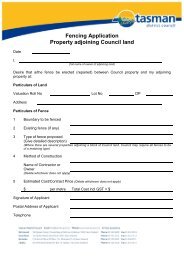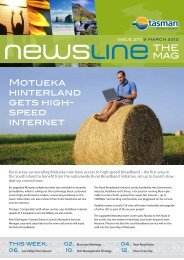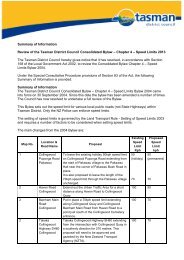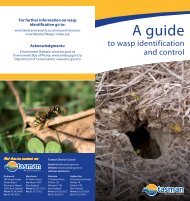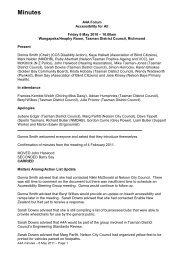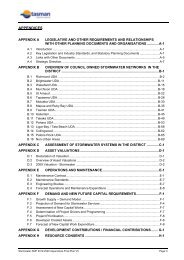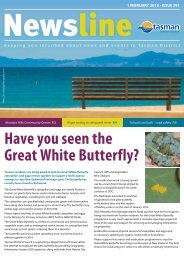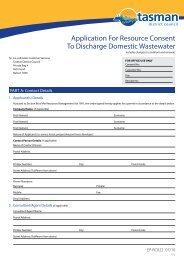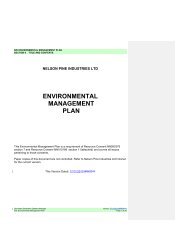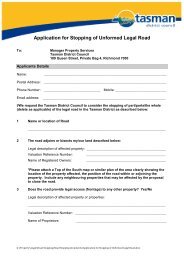Abel Tasman Foreshore Scenic Reserve Draft Management Plan
Abel Tasman Foreshore Scenic Reserve Draft Management Plan
Abel Tasman Foreshore Scenic Reserve Draft Management Plan
Create successful ePaper yourself
Turn your PDF publications into a flip-book with our unique Google optimized e-Paper software.
3. Conservation of natural resources<br />
Natural resources include unique species and special places that are appreciated and<br />
enjoyed for their intrinsic values, for what they offer to future generations, and for<br />
their contribution towards our identity as New Zealanders. Many of the natural<br />
features of the <strong>Abel</strong> <strong>Tasman</strong> coastline contribute to New Zealand’s international<br />
reputation as a country with outstanding natural values.<br />
The coastal area is characterised by a mild climate with sea breezes, summer<br />
droughts and some winter frosts. Average annual rainfall is between 1400 and 1800<br />
mm, and rain falls on average 125 days per year. The coastline is one of the sunniest<br />
in the country, with approximately 2200 hours of sunshine per year. The average<br />
maximum summer temperature is 24 o C, with overnight minimums of approximately<br />
13 o C. Winter temperatures range from an average maximum of 12.5 o C to a minimum<br />
of 4 o C. During late spring and throughout summer the coast can be subjected to<br />
strong westerly winds, particularly in the afternoon. The autumn and winter months<br />
are generally calmer, but the occasional storm does occur.<br />
3.1 Terrestrial, freshwater and marine species, habitats and<br />
ecosystems<br />
The <strong>Abel</strong> <strong>Tasman</strong> coastal marine environment is relatively free of the modifications<br />
and impacts more commonly found around the coastal margins of New Zealand. The<br />
estuaries are largely intact and are protected from sedimentation and pollution<br />
normally associated with human activities, as the streams and rivers flow from<br />
untouched and regenerating forested catchments. The rocky shores are, in most parts<br />
of the reserve, backed by a continuous cover of indigenous forest or scrub that is<br />
protected within <strong>Abel</strong> <strong>Tasman</strong> National Park. This intact ecological continuity<br />
between the sea, estuaries, rivers and the land is relatively rare in many parts of New<br />
Zealand.<br />
The dominant granite bedrock and a marine environment free of oceanic swells<br />
provide habitats and ecological associations of national and international scientific<br />
interest. The <strong>Abel</strong> <strong>Tasman</strong> coast is a discrete area where the full range of the<br />
relatively diverse <strong>Tasman</strong> Bay and Golden Bay shore types is represented. The nine<br />
broad intertidal habitats and substrates that are present in or associated with the<br />
reserve are described below. These ecosystems are all connected and inter-related.<br />
(i)<br />
Soft shores<br />
Two types of soft shore habitats are present within the reserve: estuaries; and the<br />
open coast beaches and spits. Estuaries are partially enclosed by land, sand spits, or<br />
bars, and receive freshwater from streams and salt water from the sea. Within<br />
estuarine areas, there are four substrate categories (coarse sand, sand, fine sand and<br />
mud) and two plant assemblage types (eelgrass beds and salt marsh/herbfields).<br />
Fifteen estuaries are present in the reserve, ranging in size from 290 ha (Awaroa<br />
Inlet) to less than one hectare. Open coast beaches and spits are soft shores exposed<br />
to the open sea. They are dominated by sand or coarse sand, depending on the degree<br />
of exposure or wave action. Soft shore habitats comprise 87% of the reserve<br />
(estuaries 67% and open coast 20%).<br />
3. Conservation of natural resources 19



